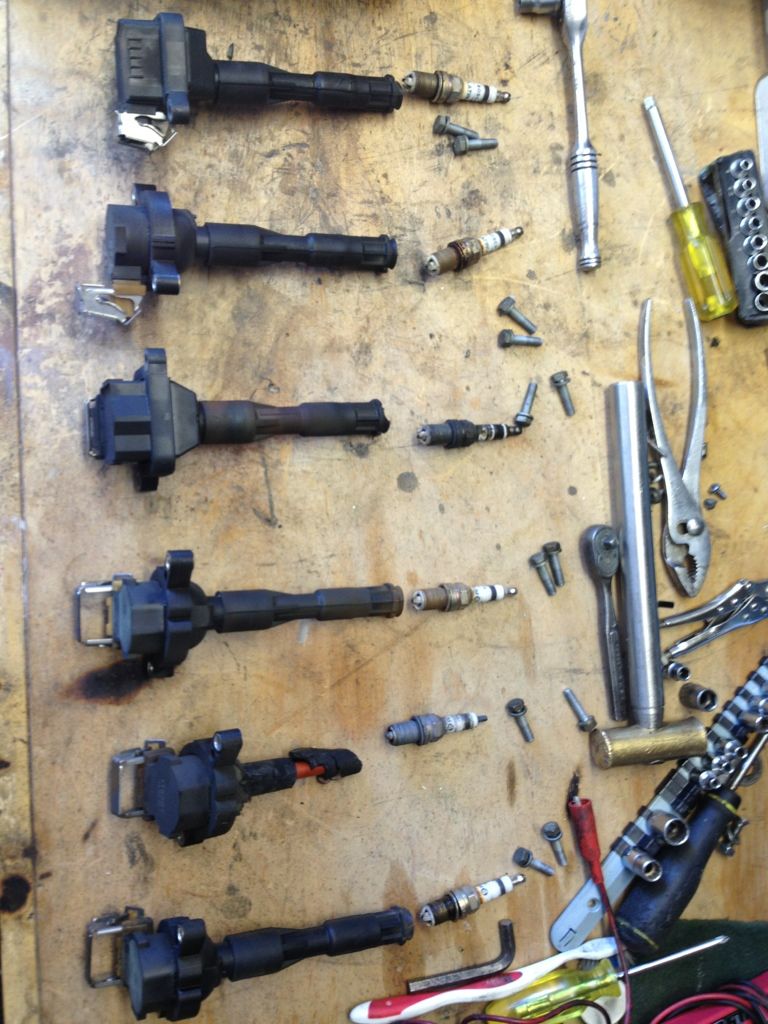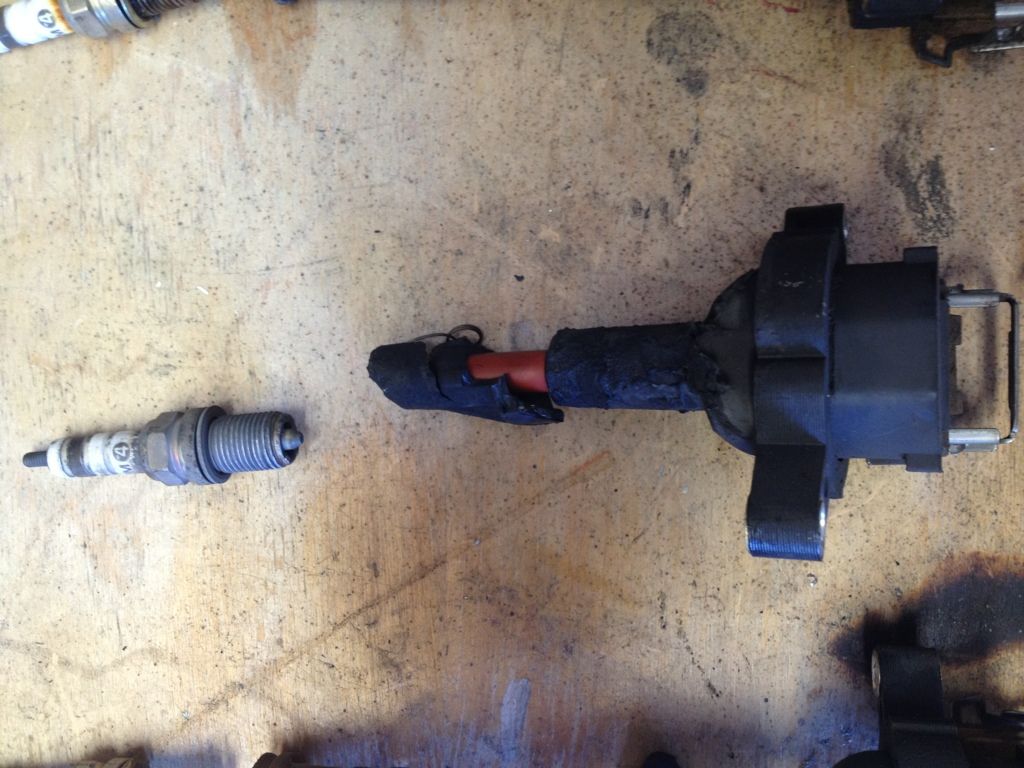Rupunzell
Bernice Loui
Miata Story...
We purchased a new Miata in 1997. Quite reliable and OK as a daily driver for years and years unit it was put into track day duty. The perception was the Miata should be fine stock as a track day car due to the number of Spec Miatas raced each year and the number of other Miata owners who drive their daily driver Miata to track days and back..
Until this happened:
[ame="http://www.youtube.com/watch?v=57YbtyNYGiQ&feature=plcp"]When Miya Broke 071112 - YouTube[/ame]
Turns out there was far more wrong than just a broken spark plug electrode. The Crank Angle Sensor which drives the twin coil wastes spark ignition system died (very common problem in 1990 to 1998, NA Miata) causing the ignition to be 30 degrees retarded. Replace it but that did not solve the problem completely. The engine still rattles.
This caused me to dig into the inner workings of the Miata in ways never intended. Turns out the more I learned, the more I really dis-like this car.
The temperature gauge has been designed to deceive the owner/driver. It has a response curve shaper circuit designed into the temperature gauge to give the owner/driver the impression you Miata is doing fine even when the engine is in serious heat trouble. When the discovery of this circuit of the temp gauge was discovered, my eyes rolled..
http://www.miataforumz.com/how-40/how-linear-water-temp-gauge-245/
The smoking gun that I believe that drove the Miata engineers to do this was the poorly adapted cooling system for the engine that was originally designed for FWD. The cooling system was originally designed to flow coolant from cylinder one in the block and exit from cylinder four at the top of the cylinder head... similar to the Fiat. In the case of the Miata since it was a front engine/rear drive car, the Maita engineers decided to flow coolant from the front of the block at cylinder one and exit at cylinder one on the cylinder head and use the heater core to help cool cylinder three & four. This does not work so well. It might be OK for daily driven cars that are not really pushed, if pushed, the engine is very prone to over heating.
The Miata DIY folks discovered this and re-routed the cooling system to improve it significantly. Most telling is Dave Coleman who is an engineer at Mazda USA did this to their Eye Sore Racing turbo Miata that is raced at LeMons to help with the designed in cooling problem.
http://www.solomiata.com/CoolantReroute.html
This design problem appears in Miata built from 1990 to 2005 !
Then we have the issue of stuck hydraulic lifters. Very common problem in Miata. Eventually, Mazda gave up on the hydralic lifters and went to a solid lifter set-up with shim adjustment on the top... very similar to Fiat. Except their design can result in the shim popping out in during extended high RPM running as Spec Miata racers discovered.
We purchased a spare engine locally for the spare cylinder head. Removal of the cylinder head revealed more discoveries. The cast iron cams tends to wear on one edge and by the looks of the wear pattern and cracks, these cams do wear out in time. The cylinder head is typical of modern 4 valve design using a multi layer steel head gasket. The bore & stroke appears to be lifted from the Fiat Twin Cam, but 1.8L engine has a pathetic stroke to connecting rod ratio of 1.56:1 (Con rod length 133mm, stroke 85mm). No wonder why this engine does not like to rev and tends to be gravelly and not very sporty. At some point, the bottom end will be taken apart and more will be discovered.
The stock suspension corners on calibrated bump stops. Or the spring/damper combo is set up soft and when the chassis is cornered hard, the bump stops limit body roll.. Wow...
Topping that off is a chassis that is not as stiff and rigid as it should be.
Then we have differentials that tend to fail. This problem was addressed by Mazda in later years.
I'll post more about what actually failed in our 1997 Miata when the cylinder head is removed next week.
IMO, these are not as good as they are believed to be and when pressed into hard driving, more serious design problems appear. It is clear the Mazda folks designed this car for a specific road duty and not much beyond that.
Bernice
We purchased a new Miata in 1997. Quite reliable and OK as a daily driver for years and years unit it was put into track day duty. The perception was the Miata should be fine stock as a track day car due to the number of Spec Miatas raced each year and the number of other Miata owners who drive their daily driver Miata to track days and back..
Until this happened:
[ame="http://www.youtube.com/watch?v=57YbtyNYGiQ&feature=plcp"]When Miya Broke 071112 - YouTube[/ame]
Turns out there was far more wrong than just a broken spark plug electrode. The Crank Angle Sensor which drives the twin coil wastes spark ignition system died (very common problem in 1990 to 1998, NA Miata) causing the ignition to be 30 degrees retarded. Replace it but that did not solve the problem completely. The engine still rattles.
This caused me to dig into the inner workings of the Miata in ways never intended. Turns out the more I learned, the more I really dis-like this car.
The temperature gauge has been designed to deceive the owner/driver. It has a response curve shaper circuit designed into the temperature gauge to give the owner/driver the impression you Miata is doing fine even when the engine is in serious heat trouble. When the discovery of this circuit of the temp gauge was discovered, my eyes rolled..
http://www.miataforumz.com/how-40/how-linear-water-temp-gauge-245/
The smoking gun that I believe that drove the Miata engineers to do this was the poorly adapted cooling system for the engine that was originally designed for FWD. The cooling system was originally designed to flow coolant from cylinder one in the block and exit from cylinder four at the top of the cylinder head... similar to the Fiat. In the case of the Miata since it was a front engine/rear drive car, the Maita engineers decided to flow coolant from the front of the block at cylinder one and exit at cylinder one on the cylinder head and use the heater core to help cool cylinder three & four. This does not work so well. It might be OK for daily driven cars that are not really pushed, if pushed, the engine is very prone to over heating.
The Miata DIY folks discovered this and re-routed the cooling system to improve it significantly. Most telling is Dave Coleman who is an engineer at Mazda USA did this to their Eye Sore Racing turbo Miata that is raced at LeMons to help with the designed in cooling problem.
http://www.solomiata.com/CoolantReroute.html
This design problem appears in Miata built from 1990 to 2005 !
Then we have the issue of stuck hydraulic lifters. Very common problem in Miata. Eventually, Mazda gave up on the hydralic lifters and went to a solid lifter set-up with shim adjustment on the top... very similar to Fiat. Except their design can result in the shim popping out in during extended high RPM running as Spec Miata racers discovered.
We purchased a spare engine locally for the spare cylinder head. Removal of the cylinder head revealed more discoveries. The cast iron cams tends to wear on one edge and by the looks of the wear pattern and cracks, these cams do wear out in time. The cylinder head is typical of modern 4 valve design using a multi layer steel head gasket. The bore & stroke appears to be lifted from the Fiat Twin Cam, but 1.8L engine has a pathetic stroke to connecting rod ratio of 1.56:1 (Con rod length 133mm, stroke 85mm). No wonder why this engine does not like to rev and tends to be gravelly and not very sporty. At some point, the bottom end will be taken apart and more will be discovered.
The stock suspension corners on calibrated bump stops. Or the spring/damper combo is set up soft and when the chassis is cornered hard, the bump stops limit body roll.. Wow...
Topping that off is a chassis that is not as stiff and rigid as it should be.
Then we have differentials that tend to fail. This problem was addressed by Mazda in later years.
I'll post more about what actually failed in our 1997 Miata when the cylinder head is removed next week.
IMO, these are not as good as they are believed to be and when pressed into hard driving, more serious design problems appear. It is clear the Mazda folks designed this car for a specific road duty and not much beyond that.
Bernice



